main |
sidebar





Louise Moillon (1610–1696) was a French painter in the decorative era. She became known as one of the best female still life painters during her time, and worked for King Charles I of England, as well as the French nobility.
Biography:
Moillon came from a strict Calvinist family. Her father, Brother Isaac, and stepfather were both paint dealers and artists themselves. According to the RKD, Louise learned to paint from her father Nicolas Moillon and Francois Garnier. She gained her particular style of still life painting from the Academia de Saint-Germain-des-Pres. She usually signed her paintings with Louyse Moillon.Moillon lived and worked in France her whole life.
Paintings:
The majority of her work was done in the 1630s, before her marriage in 1640 to wealthy timber merchant Etienne Girardot de Chancourt. Though her last dated work is from 1645, she died of heart failure during 1696. Her work continues to be admired for its quiet style.

Four still-life paintings, once thought to be Moillon's, have now been reattributed to Osias Beert, a Flemish still life artist.
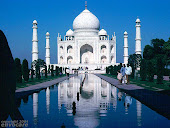
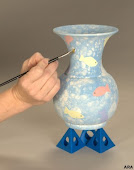


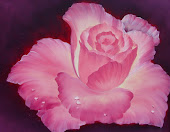
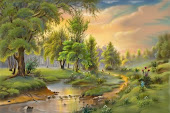


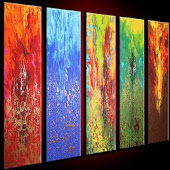

Tuesday, November 29, 2011

I and the Village may be a 1911 painting by the Russian-French artist Marc Chagall. It is currently exhibited at the Museum of Modern Art, New York.
The work contains several soft, dreamlike images overlapping each other in a continuous space: within the foreground, a cap-wearing green-faced man stares at a goat or sheep with the image of a smaller goat being milked on its cheek. In the foreground maybe a glowing tree held in the man's dark hand.
The background features a collection of houses next to an Orthodox church, and an upside-down female violinist in front of a black-clothed man holding a scythe. Note that the green-faced man wears a necklace with St. Andrew's cross, indicating that the man is a Christian. As the title suggests, I and the Village is influenced by memories of the artist's place of birth and his relationship to it.
The significance of the painting lies in its seamless integration of various elements of Eastern European folktales and culture, both Russian and Yiddish. Its clearly defined semiotic elements and daringly whimsical style were at the time considered groundbreaking. Its frenetic, fanciful style is credited to Chagall's childhood memories becoming, in the words of scholar H.W. Janson, a "cubist fairy tale" reshaped by his imagination, without regard to natural color, size or even the laws of gravity.
Thursday, November 24, 2011

Sandstone is a sedimentary rock composed mainly of sand-sized minerals or rock grains.

Some sandstone are resistant to weathering, yet are easy to work. This makes sandstone a common building a paving material. However, some that have been used in the past, such as the Collyhurst sandstone used in North West England, have been found less resistant, necessitating repair and replacement in older buildings.
Most sandstone is consists of quartz and/or feldspar because these are the most common minerals in the Earth's crust. Like sand, sandstone may be any color, but the most common colors are tan, brown, yellow, red, gray, pink, white and black. Since sandstone beds often form highly visible cliffs and other topographic features, certain colors of sandstone have been strongly identified with certain regions.
Rock formations that are primarily composed of sandstone typically allow percolation of water and other fluids and are porous enough to store large quantities, making them valuable aquifers and petroleum reservoirs. Fine-grained aquifers, such as sandstones, are more apt to filter out pollutants from the surface than are rocks with cracks and crevices, such as limestone or different rocks fractured by seismic activity.
Sandstone is mined by quarrying. It is sometimes found where there used to be small sea areas. It is usually formed in deserts or dry places like the Sahara Desert in Africa, the Arabian Desert in the Middle East and the Australian desert. In the western United States and in central Australia, most sandstone is red.
Uses:
Sandstone has been used for domestic construction and house wares since prehistoric times, and continues to be used.
Sandstone was a popular building material from ancient times. It is relatively soft, making it easy to carve. It has been widely used around the world in constructing temples, cathedrals, homes other buildings. It has also been used for artistic purposes to create ornamental fountains and statues.

Some sandstone are resistant to weathering, yet are easy to work. This makes sandstone a common building a paving material. However, some that have been used in the past, such as the Collyhurst sandstone used in North West England, have been found less resistant, necessitating repair and replacement in older buildings.
Because of the hardness of individual grains, uniformity of grain size and friability of their structure, some types of sandstone are excellent materials from which to make grindstones, for sharpening blades and other implements. Non-friable sandstone can be used to make grindstones for grinding grain, e.g., grit stone.
Monday, November 14, 2011

Lake Geneva or Lake Leman could be a lake in Switzerland and France. It is one among the largest lakes in Western Europe.59.53 % 345.31 km2 of it comes under the jurisdiction of Switzerland, and 40.47 % 234.71 km2 under France. The average surface elevation of 372 m (1,220 ft) higher than ocean level is controlled by the Seujet Dam near Geneva.
Lake Geneva, shaped by a retreating glacier, has a crescent form that narrows around Yvoire on the southern shore. It will thus be divided figuratively into the "Grand Lac" to the east and also the "Petit Lac" (Small Lake) to the west. The Chablais Alps border its southern shore, the western Bernese Alps lie over its eastern aspect. The high summits of Grand Combin and Mont Blanc are visible from some places. Compagnie Generally de Navigation sur le lac Leman (CGN) operates boats on the lake.

The lake lies on the route of the Rhone. The river has its source at the Rhone Glacier close to the Grimsel Pass to the east of the lake and flows down through the Canton of Valais, getting into the lake between Villeneuve and Le Bouveret, before flowing slowly towards its egress at Geneva.
Lake Geneva is that the largest body of water in Switzerland, and greatly exceeds in size all others that are connected with the main valleys of the Alps. It is within the shape of a crescent, with the horns pointing south, the northern shore being 95 km (59 mi), the southern shore 72 km (45 mi) in length. The crescent form was more regular during a recent geological period, when the lake extended to Bex, regarding 18 km (11 mi) south of Villeneuve. The detritus of the Rhone has filled up this portion of the bed of the lake, and it seems that within the historical period the waters concerning about 2 km (1.2 mi) beyond the present eastern margin of the lake.
The greatest depth of the lake, within the broad portion between Evian and Lausanne, where it is just 13 km (8.1 mi) in width, has been measured as 310 m (1,020 ft), putting the bottom of the lake at 62 m (203 ft) above sea level. The lake's surface is the lowest point of the cantons of Valais and Vaud.
The snowy peaks of the Mont Blanc are shut out from the western end of the lake by the ridge of the Voirons, and from its eastern end by the bolder summits of the Grammont, Cornettes de Bise and Dent d'Oche, but are seen from Geneva, and between Nyon and Morges.
Thursday, November 3, 2011

Louise Moillon (1610–1696) was a French painter in the decorative era. She became known as one of the best female still life painters during her time, and worked for King Charles I of England, as well as the French nobility.
Biography:
Moillon came from a strict Calvinist family. Her father, Brother Isaac, and stepfather were both paint dealers and artists themselves. According to the RKD, Louise learned to paint from her father Nicolas Moillon and Francois Garnier. She gained her particular style of still life painting from the Academia de Saint-Germain-des-Pres. She usually signed her paintings with Louyse Moillon.Moillon lived and worked in France her whole life.
Paintings:
The majority of her work was done in the 1630s, before her marriage in 1640 to wealthy timber merchant Etienne Girardot de Chancourt. Though her last dated work is from 1645, she died of heart failure during 1696. Her work continues to be admired for its quiet style.

Four still-life paintings, once thought to be Moillon's, have now been reattributed to Osias Beert, a Flemish still life artist.
;;
Subscribe to:
Posts (Atom)
Tajmahal Paintings

Painting Iteams

Creation of Paintings

Painting Equipments

Beautiful Rose Painting

Green Nature Painting

Canvas Painting

Pictute of Artist

Color Paintings

Online Paintings
